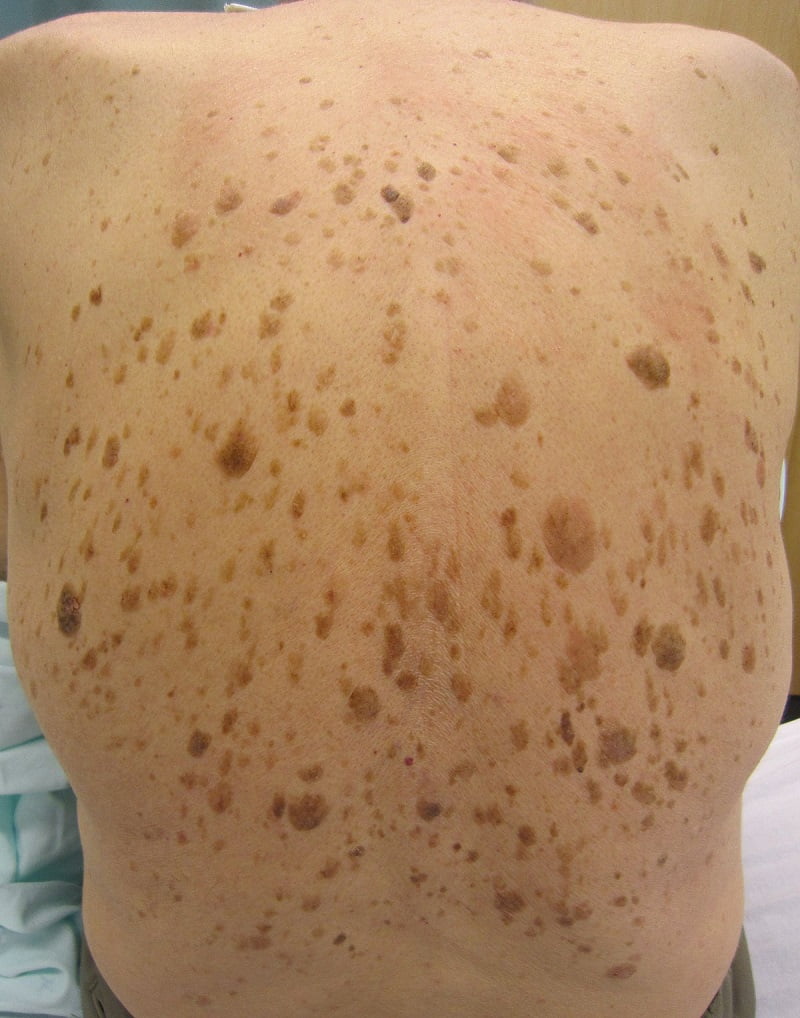Dark spots on the skin are also known as hyperpigmentation. It is happening when some areas of the skin produce more melanin than usual. Melanin is giving the hair, skin and eyes their color. Dark spots on the skin are not a reason for concern and they do not need treatment. But, many people choose to remove dark spots for a cosmetic reason. Some people may call some types of dark spots on the skin age spots or sunspots depending on the cause.
It is not always possible to prevent dark spots on the skin from developing. Hormonal changes during pregnancy which may lead to melasma are not preventable. In the most cases, dark spots on the skin are not harmful. [1]

Dark spots symptoms
Dark spots on the skin can range from light brown to dark brown. The color of the dark spot may depend on the tone of the person’s skin. These spots are the same texture as the skin and they are not painful. Also, dark spots can vary in size and they can develop on any part of the body. But, they are most common in areas often exposed to the sun. Dark spot are common in the next areas: shoulders, back, face and back of the hands.
In people, who have dark skin, a spot which is a few shades darker than the skin, usually fades away within 6 – 12 months. Deeper coloration is taking years to fade. The deep color change often appears as gray or blue, though a spot may also be a much darker brown that the persons normal skin color. Your doctor or your dermatologist will find the cause for dark spot on your skin by examining them and taking your medical history. The healthcare professional might perform a Wood’s lamp skin exam during the physical exam, where the view the spots through a special device that emits black lights.
In some cases, specific characteristics of a spot may need more tests to make sure skin cancer is not causing the spot. It is very important to talk with your doctor if any dark spot on the skin bleeds, itches, tingles, appears suddenly and changes color or size. Your doctor will see the cause for your dark spot, so he or she can give you the best treatment needed for your condition.
Dark spots causes
There can be different causes for dark spots on the skin, such as
- Hormonal changes: Melasma is a skin condition, which leads to small patches of skin discoloration and this condition is more common in women, especially during pregnancy. Hormones can trigger melasma. [1]
- Sun damage: Sun damage is also known as liver spots, solar lengtinges or sunspots. People can develop dark spots on their skin after they have been exposed to the sun or tanning beds. Areas of the body which receive the most sun exposure, such as arms, hands or face are most likely to develop sun spots. Arms, hands or face are areas of the body which receive the most sun exposure and they are most likely to develop sun spots. [2,3]
- Diabetes: This condition can cause areas of the skin to become darker. Some conditions which are associated with diabetes include acanthosis nigrican, which causes darkened and velvety skin and shin spots or diabetic dermopathy, which people can confuse with age spots. [4]
- Irritation: Hair products or cosmetic products can irritate the skin and this is causing dark patches to form.
- Wound healing: Dark spots can remain after a cut heal, burn heal or insect bite and they may fade with time. [5]
- Inflammation: Dark spots can develop after a bout of inflammation on the skin. Inflammation can happen for many different reasons, such as acne, injury to the skin, psoriasis and eczema. [6]
- Medication side effects: Some medications can increase the skin pigmentation and this can cause dark spots. The most common culprits are NSAIDs (non – steroidal anti – inflammatory drugs), psychotropic drugs and tetracyclines.
Risk factors
Every single person can develop dark spots on their skin. But, there are some factors which increase the risk of a person to develop dark spots, such as
- Diabetes [4]
- Liver disease
- Medications that increase pigmentation [7]
- Trauma or injury to the skin
- Skin conditions, such as psoriasis, eczema or acne
- Pregnancy [1]
- Sun exposure [2,3]
References:
[1] Massinde A, Ntubika S, Magoma M. Extensive hyperpigmentation during pregnancy: a case report. Journal of Medical Case Reports. 2011;5.
[2] Brenner M, Hearing VJ. The protective role of melanin against UV damage in human skin. Photochemistry and Photobiology. 2008;84(3):539–49. doi:10.1111/j.1751-1097.2007.00226.x
[3] Bonilla C, Ness AR, Wills AK, et al. Skin pigmentation, sun exposure and vitamin D levels in children of the Avon Longitudinal Study of Parents and Children. BMC Public Health. 2014;14.
[4] Mendes AL, Miot HA, Junior VH. Diabetes mellitus and the skin. Anais Brasileiros de Dermatologia. 2017;92(1):8–20.
doi:10.1590/abd1806-4841.20175514
[5] Chadwick S, Heath R, Shah M. Abnormal pigmentation within cutaneous scars: A complication of wound healing. Indian Journal of Plastic Surgery. 2012;45(2):403–11. doi:10.4103/0970-0358.101328
[6] Davis EC, Callender VD. Postinflammatory hyperpigmentation: A review of the epidemiology, clinical features, and treatment options in skin of color. Journal of Clinical and Aesthetic Dermatology. 2010;3(7):20–31.
[7] Sayal SK, Das AL, Chattwal PK. Study of cutaneous manifestations in chronic liver disorders. Medical Journal Armed Forces India. 1997;53(4):263–6. doi:10.1016/S0377-1237(17)30750-5




